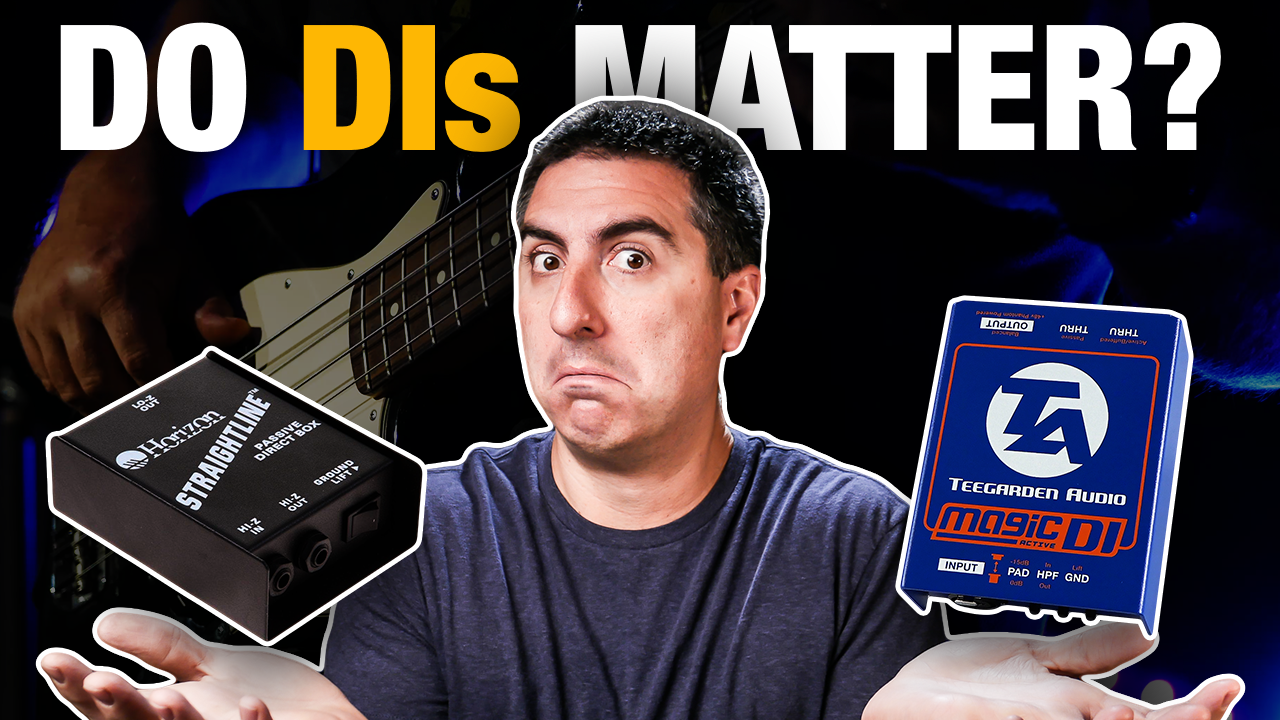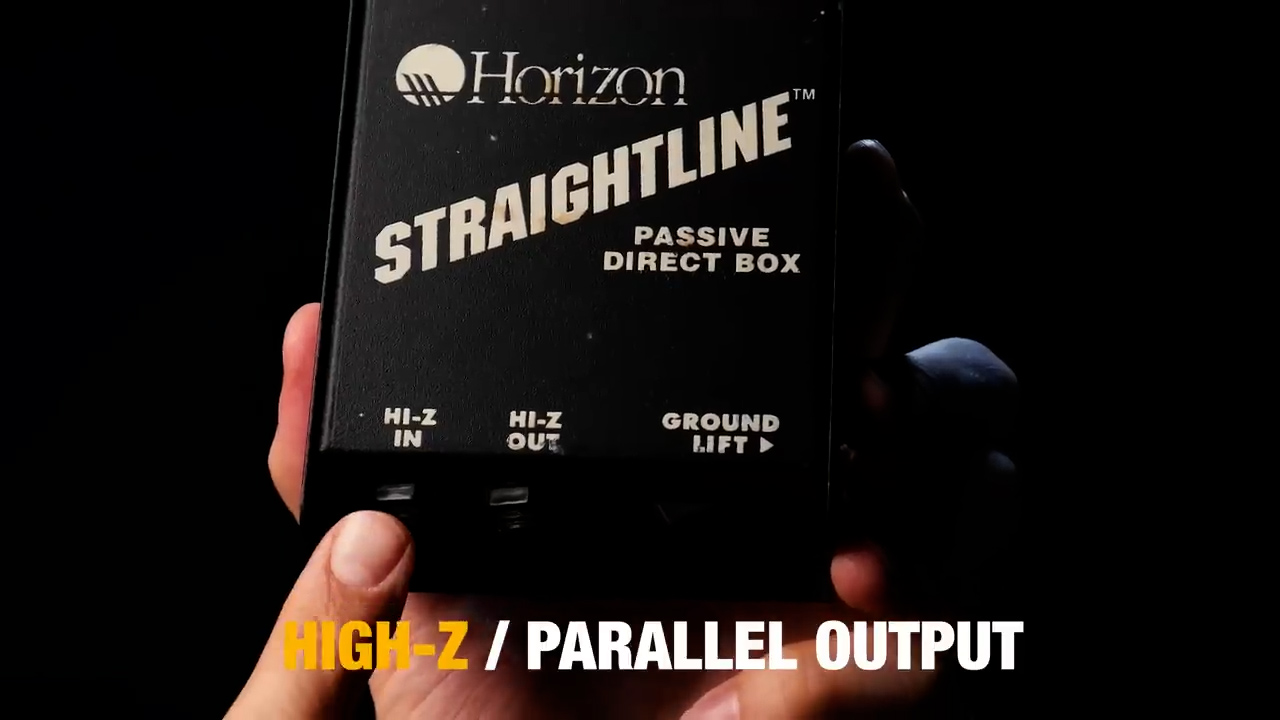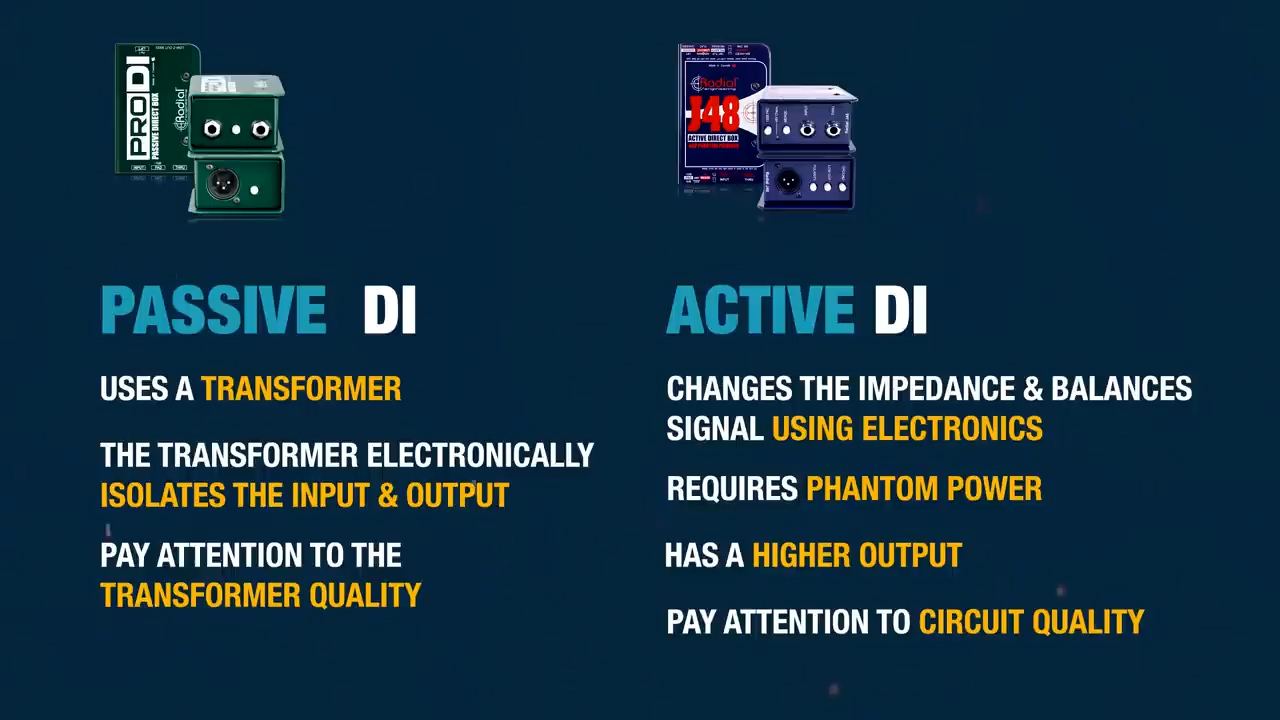Do Direct Boxes Matter? What's a DI do?

Does a direct box really matter? What does a direct box even do? And does one make a difference over another one? Let's jump in and find out!
Hey! If you're new here, my name is James and I help worship leaders and sound techs help eliminate the mystery and frustration around sound at church.
Understanding Impedance
When connecting a guitar or a bass to our sound system, we have to run it to the soundboard. And that mic-pre on the soundboard is looking for a mic level signal. Now, a mic level signal is balanced and low impedance. But the problem is that the output on our instruments is usually high impedance and unbalanced. Well, what do those terms even mean?
Let's start with the impedance, and I will try not to get too terribly nerdy because it does get deeper than I can handle pretty quickly. Impedance is kind of like a straw or a tube that's passing water through it. A smaller tube versus a bigger tube is going to behave differently, especially when we get into longer distances. A high impedance signal is kind of like a drinking straw. A straw is just fine for drinking several inches down to the bottom of your Coke can. But if we're trying to water a garden with a drinking straw, we're going to have a really tough time doing it. For a longer distance, you need a larger diameter hose. And if you're trying to put out a fire, a fire hose is a lot bigger than a garden hose. The same thing applies to our audio signals.
For the longer run when we need to go from our stage to the console, we need a lower impedance signal, which is like having a bigger tube or hose. What this might mean for you in the real world is that if you have a long, high impedance signal, you're going to get some signal loss, you're going to get some high frequency loss, and you might also get some more noise. But noise is mostly a factor of a balanced signal, which is the other thing a DI does.
What Does an Unbalanced Vs. Balanced Signal Mean?
Most instruments are unbalanced on their output, so if it's unbalanced, what does balanced mean? Electronic stuff likes to go in a circle. That's why they call them circuits. So usually, with our guitar signal, we have the hot signal on one side and the neutral or the ground on the other side. This correlates to the tip and the sleeve of your TS connector that plugs into your guitar. Because we're going to amplify the signal a lot, we also need a shield, which is kind of like a tinfoil hat for all of us conspiracy theorists.
So the unbalanced audio signal has the tip that's carrying the signal and the sleeve, which is carrying the ground. Two conductors, plus a shield. So our tinfoil hat, I mean…the shield, is not enough to keep it from picking up a lot of electromagnetic and radio frequency interference on the way to the console. On a balanced signal, we have a third conductor, which carries the same signal on the tip, but polarity inversed. So when we get to our mic preamp, it's looking for a balanced signal on the input. So it combines them, flips the polarity on one, and that way, any noise that came in between that source and that mic pre gets canceled out by a polarity inversion. That noise gets eliminated.
So if we take a look at a DI, it's got a couple of features on it that are just standard. There's the input jack, which is where we plug our stuff into. Inside there's a transformer, and this transformer both isolates the signal from one side to the other and the number of windings on the transformer determines the impedance for the input and the output. These are in a ratio. Our XLR connector is on the output of this transformer, and so now we can have it both balanced and low impedance.
Other Important Features of a Direct Box to Consider
Another thing you'll see on your DI is a ground lift switch. This disconnects the ground from the output of the XLR connector for a phenomenon called a ground loop. In all my years of doing audio, I still don't exactly know what happens when a ground loop is there, but I do know that it sounds like a 60-cycle hum, and that lifting the ground on one of your components can sometimes break this ground loop, which causes things to improve and become less noisy. But in general, it's best to have it on rather than off, and lift means we're disconnecting it. So if you have it switched away from where it says lift, that means that the ground is connected and it's fully grounded all the way through the system.
Some DIs also have a pad for when the instrument's output is hotter than what you want it to run into that DI or into your mic pre. Some DIs can distort if the input level is too high, and sometimes you want to have a little more control over the signal level at the preamp, so maybe you want to run your preamp hotter and have it padded at the DI.
You might also see a HI-Z or parallel output on your DI. This takes the high impedance signal and just connects it to another jack so that you can come out of the DI into an amp or a pedalboard or some other signal path so that you can take the clean signal off the DI and maybe a distorted signal through a pedalboard or into an amplifier.

Some other DIs get fancy with a buffered output in addition to the parallel output and even a high pass filter. Who knew there were such possibilities? In all reality though, the passive versus buffered situation is beyond this article's scope, so do a YouTube search if you're really curious. There's some good stuff out there!
So What Makes DIs Different From One Another?
Well, there are basically two types of DIs. There are passive DIs, and there are active DIs. Passive DIs use a transformer, and that's what I was describing earlier with the different number of windings and the iron core that's in between. It doesn't require any power to operate; it’s passive. The transformer electrically isolates the input in the output, so there's nothing actually touching. It's just a magnetic field that's making the signal go from one side of the signal to the other. One thing to pay attention to and that will affect tone is the quality of the transformer itself.

Now, an active DI changes the impedance and balances the signal, but it uses electronics inside the DI to do the job. They usually require phantom power or some other power supply, but your console probably already has phantom power, so you don't need to deal with external power supplies or nine-volt batteries, just use phantom power. It does a good job. An active DI typically has a higher output as well. This means you'll need to turn up your mic pre less if you've got a cheaper mic pre that adds noise as you turn it up, this could result in less noise in your signal.
Now the quality of the circuit matters too, and this shows up in two main places, and that's noise and frequency bandwidth. Now one of the reasons we're using the DI in the first place is to have lower noise. So if it's noisy on its own, that's not such a great situation. Frequency bandwidth means the extreme top and bottom end of the signal. So a better DI will tend to have a little bit farther than it'll reach, and that ends up being more of a feeling than anything. It's still going to be the same music, it's still going to be the same player, it’s just you might get a little bit more detail out of it.
Can You Hear The Difference?
Let's listen to some examples back-to-back of what two different DIs sound like. But before we do, recognize that these listening things are not totally scientific and that I can't eliminate all the variables. One of those variables is the way that somebody plays the take from one to another. There might be a little bit of tone variation there.
Another one is that level matching is really, really tricky and just a dB or two of level difference can totally change your perception of the low end. Also, listening on headphones or nice in-ear monitors will let you hear a little more detail than your phone speaker. So don't get too angry if you're just listening on your iPhone. And thanks to Chris and Nicky for being my players on this one!
So if you're paying attention to the numbers, you might have seen that the differences between the passive DI and the active DI weren't always exactly the same to get the same level. That's because there's a difference of input impedance. So different instruments are going to respond differently to different input impedance on the DIs. And one to another, it's going to change. So just keep that in mind, and maybe we'll do a deep dive on impedance sometime. I'll probably have to consult an expert for that one!
Which Direct Box Should You Go With?
So what's my conclusion on which direct box you should buy? I don't know that. You’ve got to decide for yourself. However, direct boxes make a baby step improvement in the sound. And most of great audio is baby steps. So it does matter.
The other problem is context. What's going to fit better in a mix versus the thing by itself? If I'm going for the most fidelity on a certain instrument, let's say an acoustic guitar that's out in front of the mics, that's playing melodies and things that really need to shine, I'm going to spend that extra money on a DI that really makes that guitar cut through. But if they're just playing something like a high hat with chords and keeping time with it, then I might not need to spend the extra money on a nicer DI.
The giant steps in tone change come from the player themselves and their instruments. The DI is just a little baby step, and sometimes that baby step really matters, especially if you're having to use a lot of compression or you need something to really shine and take up that big amount of space in your mix.
One more thing to remember is to always ask the player's opinion. When we were listening back, I asked Chris what he thought, and he actually liked the strummed guitar better with the cheaper DI. A little bit less top-end made it feel a bit warmer. But we also weren't listening in the context of a mix, and he recognized that too. Maybe that extra top-end would make that guitar really shine in the midst of other guitars or a keyboard.
As we wrap up, I want to thank Chris and Nicky for playing for me. I want to thank Brett Teegarden at Teegarden Audio for letting me borrow this DI to do this comparison and remember to check out some of my other blog posts about improving your church audio HERE.
Remember: it's all about the low end, avoid the sound tech solo, and nobody leaves humming the kick drum. We'll see you back here next time on Attaway audio.
Lead your sound team with clarity!
Sign up for your FREE guide - How to Lead Your Church Sound Team. Clarify the vision for your team, build your team, and create a clear path toward making every worship mix enjoyable.
We hate SPAM. We will never sell your information, for any reason.

